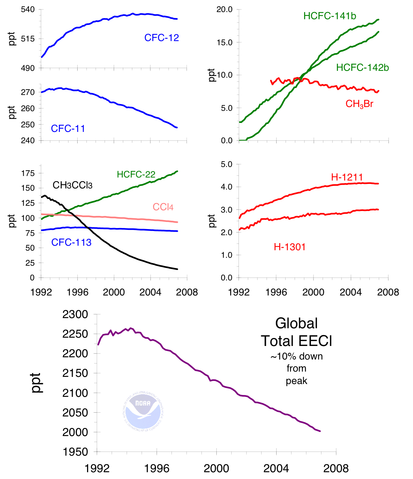 |
This is a file from the Wikimedia Commons. Information from its description page there is shown below.
Commons is a freely licensed media file repository. You can help.
|
La bildo estas kopiita de wikipedia:en. La originala priskribo estas:
Ozone-depleting gas trends and equivalent chlorine effect.
Combined chlorine and bromine in the lower atmosphere or troposphere from the most abundant chlorinated and brominated chemicals controlled by the Montreal Protocol. These changes are reflected in the upper atmosphere stratosphere (10-25 km), where most ozone loss occurs, with a delay (due to air transport) of 3-5 years. Bromine is included as an ozone-depleting chemical because although it is not as abundant as chlorine, it is 45 to 60 times more effective per atom in destroying stratospheric ozone. Earlier measurements showed that the peak of equivalent chlorine (chlorine + 45 (or 60) times bromine) occurred at the surface between mid- 1992 and mid- 1994.[CMDL20010206]
The observed decrease is driven by a large and rapid decline in methyl chloroform and methyl bromide, gases that are regulated internationally by the Montreal Protocol. The initial decline in methyl bromide was larger than that expected from projections given in the WMO/UNEP 2002 Scientific Assessment to Ozone Depletion.[CMDL20030815][CMDL27hats5]
Related images
References
- ^ News Release Feb 6, 2001. Climate Monitoring and Data Laboratory (March 17).
- ^ CMDL Scientists find that ozone-depleting bromine is now on the decline. Climate Monitoring and Data Laboratory (June 9).
- ^ Halocarbons and other Atmospheric Trace Species. Climate Monitoring and Data Laboratory Summary Report #27 (March 17).
Source
| Public domainPublic domainfalsefalse |
 |
This image is in the public domain because it contains materials that originally came from the U.S. National Oceanic and Atmospheric Administration, taken or made as part of an employee's official duties.
|
|
Source: ftp://140.172.192.211/hats/Total_Cl_Br/totCl_2004.ps from CMDL Data Archive: http://www.cmdl.noaa.gov/info/ftpdata.html
| date/time |
username |
edit summary |
| 20:44, 9 June 2005 |
en:User:SEWilco |
( more complete version) |
| 21:16, 2 April 2005 |
en:User:SEWilco |
(link to 3rd reference) |
| 15:34, 2 April 2005 |
en:User:Mozzerati |
( make into numbered list, but what's the last reference? It's not used? See Wikipedia:Footnote3) |
| 15:33, 2 April 2005 |
en:User:Mozzerati |
(update {{endnote| template to be {{note| according to recent consensus. See Wikipedia:Footnote3 and talk page.) |
| 06:32, 18 March 2005 |
en:User:SEWilco |
(updates) |
| 05:33, 18 March 2005 |
en:User:SEWilco |
(updates) |
| 05:11, 18 March 2005 |
en:User:SEWilco |
(CFC gas trends. ==Related images== Image:Major greenhouse gas trends.png|Greenhouse gas trends ==Source== {{PD-USGov-DOC-NOAA}} Source: http://www.cmdl.noaa.gov/hats/graphs/graphs.html or ftp://ftp.cmdl.noaa.gov/hats/graphs/) |
 |
This graph image could be recreated using vector graphics as an SVG file. This has several advantages; see Commons:Media for cleanup for more information. If an SVG form of this image is already available, please upload it. After uploading an SVG, replace this template with {{ vector version available|new image name.svg}}. |
File usage
The following pages on Schools Wikipedia link to this image (list may be incomplete):
All five editions of Schools Wikipedia were compiled by SOS Childrens Villages. SOS Children's Villages helps those who have nothing and no one, giving them back the famly they have lost and bringing them the very best opportunities for a happy, healthy future. You can help by sponsoring a child.






